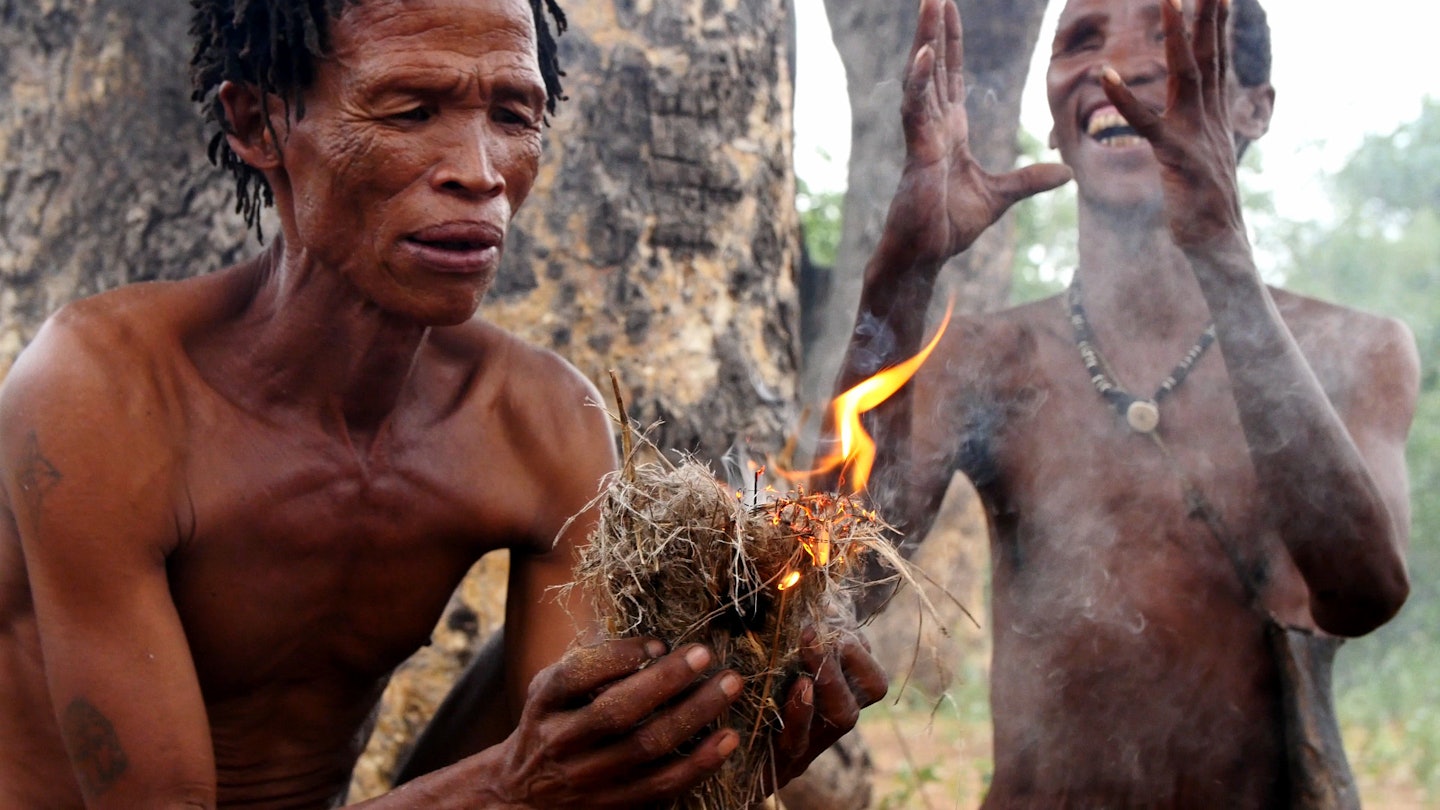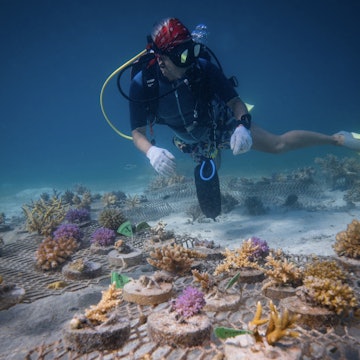

san-people-namibia-culture
On the fringes of the Kalahari Desert in Namibia, the Living Hunter’s Museum of the Ju/'Hoansi functions both as an open-air education facility for the indigenous San people (formerly known as Bushmen), and as a window for visitors into their fascinating way of life, one they have been living in the region for tens of thousands of years.
This sustainable communal business also ensures that this long-threatened heritage is understood, valued and preserved by future generations in Namibia.

Dual lives
On arrival at the reception of the Living Hunter’s Museum of the Ju/'Hoansi (in reality a large patch of red Kalahari sand shaded by a solitary Mangetti tree), scores of locals materialise to offer an effusive welcome. Some are bare-chested and dressed in traditional animal skin loin cloths, with a spear clasped in one hand and a bow and arrows slung over their shoulders; others look relaxed in jeans and t-shirts.
Henry, currently the main guide and host at the museum, perhaps best embodies the duality of the local community’s present day identity. He’s equally comfortable discussing the San’s tracking techniques and sacred animals as he is lamenting the lack of cell phone reception at the museum, or Manchester United’s latest defeat.

Folk tales around the campfire
Visitors set up their tents on the soft sand just a few hundred metres away from reception, beneath the canopy of towering Mangetti trees, and enveloped on all sides by dense bushveld. The campsite is rustic, with simple long drop toilets, bucket showers and the ubiquitous Namibian fire pit. The sense of isolation and the star-studded night sky more than make up for the lack of creature comforts.
After you’ve made dinner, you’ll likely be joined around your campfire by Henry and another male Ju/’Hoansi elder. In a well-judged theatrical flourish, Henry has now ceded his jeans and t-shirt for the more traditional regalia. He places his spear, bow and arrows carefully on the sand as he sits to translate for his companion, who in his mother tongue shares tales of close scrapes with lions and long hunting expeditions, almost every word drawing on one of the scores of palatal clicks that decorate all San languages.

A shared learning experience
The following morning, Henry leads visitors on a guided bush walk, beginning with a visit to a model San settlement. Various members of the local community gather in their traditional attire around the straw huts, and take great delight in watching visitors fail dismally to start a fire with a few sticks and some dried grass – this despite patient encouragement from Henry, who eventually takes over and gets the fire going with consummate ease.
During the bush walk, you’ll witness the incredibly intimate relationship that the Ju/’Hoansi have with the natural environment around them. You’ll learn about the various plants that they use for medicinal or nutritional purposes, as well as the poisonous ones that are applied to their arrowheads to help ensure a swift death for their prey. The local men also demonstrate how they make traps for smaller animals and birds.
A stream of younger community members follow you excitedly throughout, visibly as intrigued by the whole experience and the various tips and tricks as you are. This, after all, is central to the ethos of the Living Museum: the experiences on offer help to connect the younger generations of Ju/’Hoansi San with a heritage that has been almost entirely obliterated, diluted, or forgotten across southern Africa.

A threatened way of life
Most of the San populations in Botswana, Namibia and South Africa were violently uprooted from their ancestral homelands, hunting grounds and heritage during the colonial era. Many groups were forcibly resettled to squalid and marginalized ghettos and townships where they fell prey to the accompanying social ills; other groups have disappeared altogether with the relentless onslaught of modernity.
The Ju/’Hoansi are unique in that they continue to occupy their ancestral lands in an area formerly referred to as Bushmanland, today known as Nyae Nyae. But there are only a little more than 1000 Ju/’Hoansi left, scattered across 36 small villages in the region. Even today, these villages and their inhabitants continue to be largely isolated from the rest of Namibia, and their welfare and traditional way of life routinely neglected and undervalued.
Anyone who takes the time to veer from Namibia’s more beaten paths and visit the Living Museum of the Ju/’Hoansi-San will quickly see the importance of supporting these kinds of community-driven cultural initiatives. The first people of southern Africa still have so much to teach the rest of us, and where better for those lessons to happen than in their own backyard.

How to
The Living Museum of the Ju/’Hoansi-San is about 7km along a dirt road off the C44, near the settlement of Tsumkwe, which is about four hour’s drive from the town of Grootfontein. If self-driving, it’s recommended to have a 4WD, especially if going from the Living Museum into nearby Khaudum National Park. Or you can incorporate a visit to the museum into a guided tailor-made safari.













